Update: After over a full year of using the Z9, I have now updated this review after using firmware C4.00. You’ll see a few crossed out bits and a few new comments.
Before we get this review started, a preface, if you will.
My Z9 use began in early December 2021 with a borrowed pre-production unit that I took to Africa for three weeks. Upon arriving home, my purchased production version was waiting for me. For the last 14 weeks I've been working intensively on both testing this camera, and documenting its every nook and cranny for my Complete Guide. The Complete Guide is about to hit version 3.01 and has grown by several hundred pages over its brief history. I’ve also added a second Z9 to my bag, so have both a first-shipment and later shipment camera in my position.
I was not as gee-whiz, wow-wee positive as many of the pre-production testers were in my first comments about the camera (the Z9 in Africa blog). But I was positive. With this review, I'll also be going on record as not as gee-whiz, wow-wee positive as most reviewers have been. But again, the overall impression is positive. However, right up front I'm going to say this: the more I use and understand the Z9, the more I find bits and pieces wanting, and the more things I found in firmware C1.xx that I had to explain that Nikon marketing glossed over or skipped. This is not to say that the Z9 is a bad camera. Nope, it's an excellent, perhaps great, camera, and by far the best in the Z System lineup. As well as being one of the best interchangeable lens cameras you can buy. With the firmware updates Nikon has provided (two significant, many more minor), Nikon has also now addressed a few of the issues that came up in my initial review.
I can't help from getting the impression the Z9 development was a bit rushed, and a lot of small things ended up detracting from what could have been the best camera ever. (See the list of items at end of this review, though some have now been addressed by firmware update ;~)
Normally, Nikon's generational digital flagships have been launched on about four-year intervals:
- D1 — 1999
- D2 — 2003
- D3 — 2007
- D4 — 2012 (the extra year was because of delay due to the earthquake, tsunami, and floods of 2011)
- D5 — 2016
But the D6 started an unusual pattern, coming with far fewer changes than were expected and after only three years. Meanwhile, the Z9 could be said to be five years post D5 (or two years post D6), and has a different set of changes (no mechanical shutter being a big one). I believe something happened mid-D6 development cycle where Nikon decided to punt on most of the things they were going to do with the D6 and instead concentrate on pushing out a Z flagship more quickly instead.
Which, if I'm right, means that the flagship development cycle for the Z9 was critically short of development months. I believe that shows in so many ways on the final camera, as I'll outline in places in my review. I've got a list of almost four dozen things that should be changed in the menus, at least a half dozen potential bugs I've found, over two dozen feature/change requests, and I will point out several hardware weaknesses in the review itself. Many of these things should have been caught and dealt with in a full, all-hands-on-deck, four-year development cycle.
Overall, my reaction to the Z9 is this: "great, but wouldn't it be better if..." It's been rare that I've had that type of reaction to a new Nikon camera, though it has occurred before. Short version for you TL;DR folk: Recommended. (Now Highly Recommended after firmware updates)

What is It?
The Z9, as noted in the preface, is Nikon's new "flagship" digital camera. The term flagship is generally assumed to mean "best and most capable." It also means "expensive." The Z9 is US$5500, and sits atop the Z System camera lineup.
What's a bit unusual about that is that the D6 is still US$6500, and sits atop the DSLR camera lineup.
So right up front we have to talk about the US$1000 discrepancy in flagship prices. Given how good the Z9 is—it's not missing US$1000 worth of capability or performance—the pricing difference can only be taken to mean one thing: Nikon wants to trigger as many top-end DSLR users to migrate to mirrorless as they can. This has indeed happened. The Z9 was effectively on back-order for a year after its announcement in late October 2021, and every Nikon-using working professional photographer I know ordered one and started using it.
Nikon gave everyone plenty of early notice about the Z9 development. The development announcement in March 2021 provided only the bare minimum of details (stacked image sensor, new EXPEED chip, 8K video and a body that had a built-in vertical grip body design), but triggered plenty of speculation and discussion subsequently. The 8K and stacked image sensor were early hints that this would be a 45mp camera, not a 20mp one like the D6 (or even 24mp or 36mp). Which provoked a lot of "it won't be as good as the D6" laments online while people waited for the final camera.
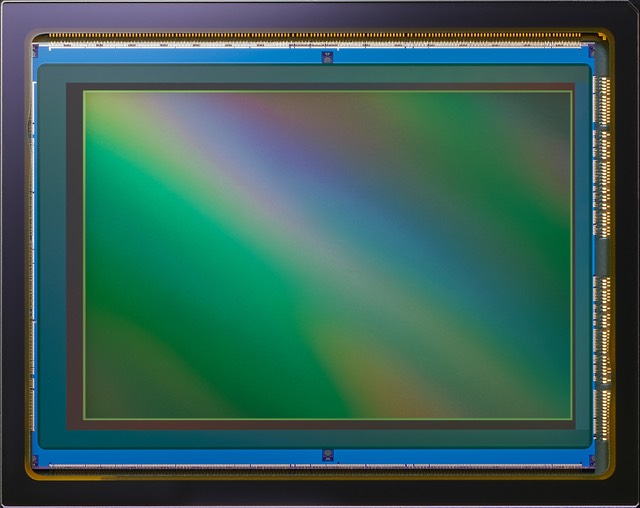
At the heart of the Z9 is an image sensor that appears derived from the D850 and Z7 family, but with extremely improved internal bandwidth capabilities, mostly enabled by the stacked sensor design, but perhaps with some tweaking of the BSI side, as well. Nikon has been mute about any technical details concerning the sensor. Close examination and testing tells me this is probably mostly the Z7 II BSI bits integrated with additional circuitry in the stacked portion. There is a change in the read noise—probably due to running faster transistors—and a change in the analog gain. But pixel level performance seems to suggest that it's the same photo diode on top, and a similar well size. Also, the autofocus implementation on the sensor is the same as the Z7 II: every twelfth blue/green row of photosites plays the dual focus/image role, as before.
Everything in the Z9 image sensor that's different appears to be solely about improving speed of moving data off sensor. And in that process, there's been a simplification, too: it appears that the Z9 sensor only moves 14-bit data. There is probably no ADC circuit adjustment for producing other bit depths from the full image data. If there is, it isn't used in the current implementation. The operating design of the Z9 image sensor is basically this: collect the data and move it off the top of the sensor stack as fast as possible, without producing much in the way of additional noise (speed = noise in most sensor designs).
ISO capabilities are 64-25600, with 32, 50, 51200, and 102400 available in Lo or Hi modes. The image sensor is dual gain, with the change point being ISO 500. (Actually, there are two other gain trigger points that mostly come up with video work.)
Coupled with the new, fast image sensor is the updated EXPEED7 image processor. Again, Nikon is being ridiculously mute about details. The most they've said is that it has 10x faster processing as previous generations. Okay. What's that mean? What was the processing power of the previous generation? (1/10th, apparently ;~).
EXPEED has always been built around what today is the Socionext SoC (system on a chip), which is the direct descendent of the Fujitsu Milbeaut chip Nikon originally used. These chips are centered around ARM cores, much like your smartphone, with additional functionality powered by a built-in GPU and video CODEC, plus additional circuitry the company the chip is produced for can provide. Indeed, we know that inside the EXPEED7 that there's at least one additional new engine, licensed from intoPIX, which provides much of the high-end video and High Efficiency NEF capabilities. (We don't know how much additional integration has been done, or how small the EXPEED7 process size has dropped to. Socionext now offers as small as 6/7nm process size, putting it the Qualcomm SnapDragon range. My guess based upon discussion with those using variations of the chip, however, is that EXPEED is using the 12/16nm process that Socionext offers, and certainly no larger than 28nm due to the functions I know live in the EXPEED chip.)
Between the image sensor and the EXPEED7 chip are two data pipelines running at 120Hz (which is what generates the 120 fps maximum frame rate and the 120 fps focus data stream). The first pipeline goes to the usual image processing chain. The second goes to a new viewfinder and focus processing chain.
All this speed and dual pipelines enables one of the key physical characteristics of the Z9: close to real-time, blackout-free viewfinder with no mechanical shutter needed. That's right, the Z9 doesn't have a mechanical shutter. Instead, you have electronic shutter speeds from 15 minutes to 1/32,000 second. Yes, you read those numbers correctly. Flash sync speed is only 1/200, however.
The electronic shutter is very fast, though it still uses a rolling shutter. The Z9 has the fastest electronic shutter so far in a still camera (it just edges out the Sony A1's electronic shutter). Nikon suggests that it is as fast as a mechanical shutter with a 1/250 flash sync speed (the speed at which a mechanical shutter moves from a full frame exposure to a slit scan exposure method). And indeed, in practice, that's exactly what I found. The actual scan is what I measure as 1/270 second (the Sony A1 is 1/250, and a Z5 at 14-bit is only 1/15!).
However, note one thing about losing the mechanical shutter: artifacts can be caused by the loss of the physical shutter. A mechanical shutter sits in front of the focus plane, an electronic shutter is at the focus plane. This has a small, typically unlikely, but still possible, result where items moving/changing near the frequency of the shutter appear differently. For instance, you can see small lines appearing at shutter speeds higher than 1/8000 with an SB-5000 firing in FP Auto mode (now restricted in recent firmware ;~). Those wouldn't appear with a mechanical shutter (if it could do faster than 1/8000 second ;~) because of the edge of the mechanical shutter sitting so far forward of the image plane and creating a small blur because of that. But the edge will appear on the electronics shutter of a Z9 as a thin line where the flash and the electronic shutter aren't 100% synchronized. Some third party flash units also exhibit this problem at various aperture/shutter speed settings. The Z9 is actually more accurately rendering what is happening in front of the camera, but you'll think it is an artifact ;~).
With firmware C3.00 Nikon added the ability to set shutter speeds outside the ones we’re used to. This allows you to sync the camera to the frequency of a light pulse or a display’s timing. Like on the Sony A1, you’re left to a trial and error session to dial in the exact shutter speed you need, but at least now we can do that.
With firmware C4.00 Nikon added Auto Capture, which allows you to automatically trigger the camera when certain motion, subject, and direction conditions are met. Auto Capture is currently a unique-to-Nikon tool that greatly expands the ability to use the camera as a second unintended camera, or a remote camera. And yes, it works for both stills and video.
The rolling shutter is not a big deal, so don't read too much into it. There are still some limits to the electronic shutter, but in practical use cases, you likely will never encounter them.
I've long argued about Nikon's anemic marketing. I guess I have to be careful about what I wish for, because I've managed to in the preceding paragraphs provide arguably more technical detail than Nikon has. The Z9's launch was all about marketing, marketing, marketing, and the messages were simplified to "Best. Fast. First." Nikon marketing put very little meat on those bones, using adjectives and emotions more than facts and details.
Which brings us to the other thing Nikon marketing led with (black-out free viewfinder was the first): sophisticating subject detection autofocus that is "effortless."
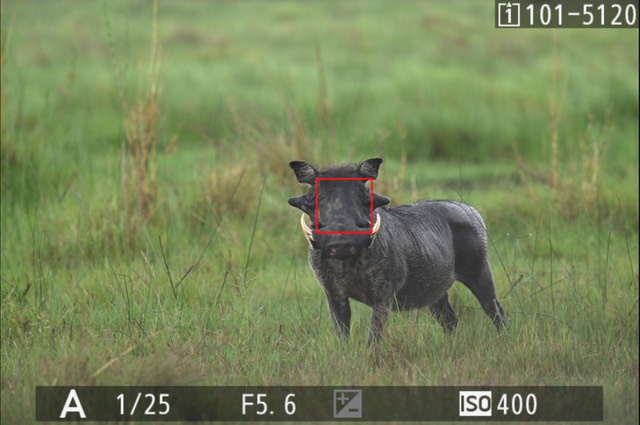
The Z9 can automatically detect and focus on humans (torso, face, eyes), animals (body, head, eyes), and vehicles (body, front, detail). Surprisingly, the engineers set the AF-area mode to Single point as default, which uses none of that ;~). Guess they didn't talk to marketing first. Marketing also calls this "scene detection," but it isn't actually detection of the scene, it's detection of a subject within a scene.
You may note that each of the subjects the Z9 can detect—and yes, animals includes birds—has a hierarchy involved. You can see this at work at times as the camera works out what to focus on (in an all-automatic mode). The Z9 may show a box on an animal's body, then narrow that to the face (see above), then further narrow that to the eyes, and that can happen in a fraction of second or instantly depending upon how confident the camera is in what it found. But the Z9 can also be less confident at times. I've seen plenty of examples in action where the camera will back off from the detail to a larger area (eyes back to head/face, for example), and that tends to be triggered by contrast/light changes. This has gotten to be less of a problem with the substantive firmware updates. Moreover, I’m surprised at how often in some previously marginal situations that the camera will snap to eye detection.
Automatic subject detection works in Auto-area AF and Wide-area AF (all four sizes). Pinpoint, Single-point AF, and Dynamic-area AF (three sizes) all use more traditional direct phase detect methodologies for finding a focus point. A welcome addition is the return of 3D-tracking, which combines subject detection with pattern/color matching. No more toggling into a tracking mode and back out, as on the previous mirrorless Nikons.
We also have the return of the AF-ON+AF-area mode and some new direct AF-area mode button-toggle options, so we now have a wide range of what's being called "hybrid focus" methods you can customize your camera to (hint: the one that made the YouTube rounds is probably not the one you want to use; I outline the options in my book). Coupled with the ability to reprogram the DISP button to a focus function, you can have as many as three autofocus control buttons at your thumb tip starting with firmware C3.00.
The focus system is (usually) being fed information at 120 fps, which means that at the top "normal" frame rate of 20 fps for still photography, the camera is getting six frames of focus data for every frame you take. That helps the camera to perform excellent tracking on moving objects.
Since we're discussing frame rates for still photography, one of the "controversial" aspects of the Z9 at launch was that "it doesn't do 30 fps like the Sony A1." Well, it does, but only as JPEG files. And with no other limitations or footnotes as you'd find in the A1 manual. Moreover, the Z9 will capture 19mp DX files at 60 fps, and full frame reduced size 11mp files at 120 fps, again with no focus, exposure, lens, or other limitations other than that they have to be JPEGs.
Since people keep asking me, I suspect that the JPEG only limitation of the three top frame rates has to do with buffer depth versus data timing. Nikon hasn't added DRAM memory to the Z9 over the earlier cameras, I believe it still only has 2GB. Thus, in order to guarantee that what comes in can still go out (;~), Nikon has limited the 30 fps, 60 fps, and 120 fps rates to JPEG only (and yes, creating a NEF file takes longer, as the camera first has to create a JPEG to embed in the NEF file).
Better still, all three of the faster frame rates (again 30, 60, and 120 fps) can be pre-buffered. That means you can set the camera so that it is constantly collecting up to a second’s data prior to your pressing the shutter release. When you do press the shutter release, that buffered second as well as up to three additional seconds can be saved as images. The days of not getting the bird on a stick taking off are gone with the Z9.
You have more flexibility of frame rate than is suggested by the 20, 30, 60, and 120 numbers. At low continuous, you can choose 1, 2, 3, 4, 5, 6, 8, and 10 fps, and at high continuous you can choose 10, 12, 15, and 20 fps. Note that those numbers all divide into 120, so they are all blackout-free in the viewfinder, too.
Even more interesting is that those can all be silent speeds, as well. Indeed, the "shutter sound" of the Z9 is all electronic, too, imitating a mechanical shutter (Nikon added four new sounds with firmware 4.0). It's sort of eerie to be taking images without the camera producing noise. Besides turning on the imitation shutter sound, you can also turn on an imitation blackout (don't worry, it doesn't ever fully black out, it really just briefly dims a frame), or two different edge line patterns in the viewfinder that show up as an image is taken. You can also have the shutter sound only applied to headphones. If you don't want the camera to even produce VR, focus, or aperture sounds, not that those are particularly detectable, you can put it in Silent mode, though this will have an impact on frame rates. Also, you can't use flash in Silent mode.
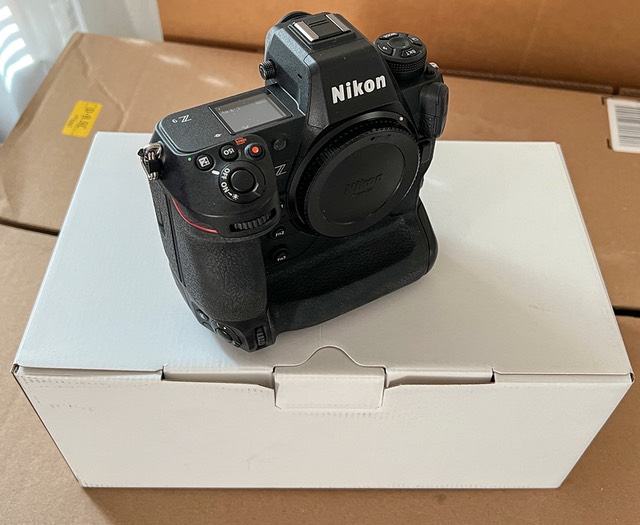
Of course, one of the important aspects of the Z9 is the body itself. Like previous Nikon DSLR flagships, the Z9 has an integrated vertical grip and a beefy, full metal frame. That frame is backed up with tons of sealing points. While Nikon demurs at providing an IP rating for the Z9, they do claim that it is well weather-sealed, and I've had the opportunity to test that several times so far, including in a full-on monsoon. I still try to keep my Z9 protected from the elements, but I'm not worried about casual mist or light rain. (One point: never rub the camera dry with a towel; always blot. Rubbing can press water into the joints, which you don't want.)
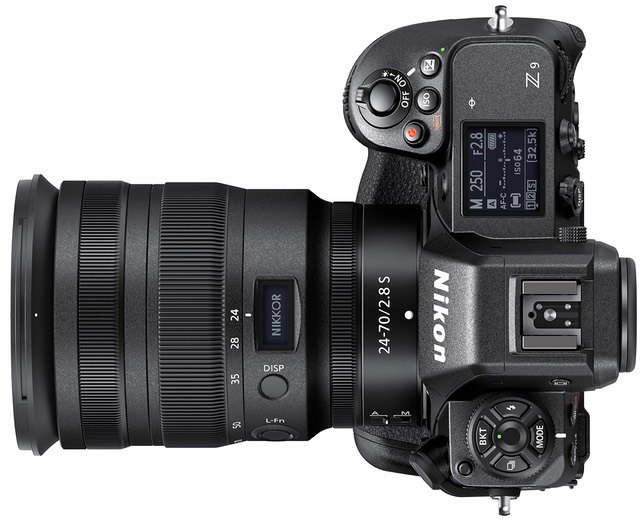
Working our way around the body, the top should look very familiar to Nikon DSLR flagship owners: button cluster to the left of the viewfinder, settings display to the right, and the now "standard" array of three buttons just behind the shutter release. Close observers will note that the two-button quick commands (reset and format card) are back. The hot shoe above the viewfinder is, unfortunately, just a Nikon-proprietary hot shoe. There isn't a special digital connector at the front as Canon and Sony have now added to their top cameras. Don't despair, if you need powered XLR mics from the camera, the 3.5mm microphone jack can provide power, and Tascam has already produced an audio accessory that uses that capability.
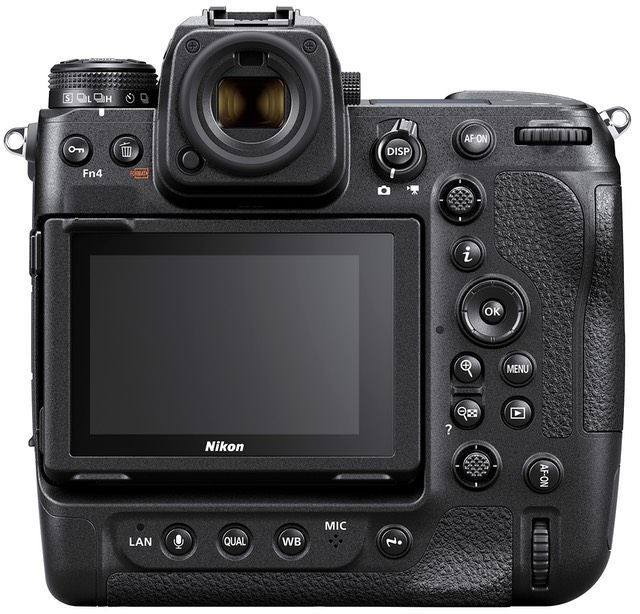
The back of the Z9 should look familiar. Yet unfamiliar ;~). Nikon has managed to merge the old DSLR flagship controls with the Z System controls pioneered with the Z6/Z7. This throws some in a tizzy at first—"the playback button isn't where I expect it!"—however Nikon's provided ways to customize the camera that should deal with most of those that have the cheese-moving jitters. I do have a number of comments in the handling section, coming up, but the real thing to note here is that the buttons below the Rear LCD have transitioned over from the DSLRs (though not including the extra settings LCD), and the vertical grip controls nicely duplicate the horizontal grip controls, right down to the i button being rotated 90° and about where you'd expect it when holding the camera vertically.

While previous flagship models have a fixed Rear LCD, the Z9 for some reason has a two-axis tilting one. It's a bit awkward to use, and it doesn't have as much tilt in either direction as I'd like, but it does mean you can attempt the overhead or underhand photos from either grip while composing on the Rear LCD. The size and resolution of the Rear LCD is still a 3.2", 2.1m dot TFT panel.
The Z9 viewfinder got a lot of flack from some at announcement by people who had never looked through it. At 3.69m dot (Quad VGA), this just "wasn't enough dots" for some, apparently. I don't know. Try putting a Quad VGA monitor just in front of your eyeball and tell me that's not enough. Nikon opted for two specific quality points with the viewfinder: (1) once again they've put high-quality optical elements between the 1/2" OLED display and your eye; and (2) the viewfinder is running 60Hz (usually) in as close to real time as we've seen in an electronic display. I've not had an issue with the quality of the viewfinder, nor have I heard a complaint from others using it in normal conditions. In really low light, or with high magnifications (zoomed in), yes, things begin to break down some, as they do for every EVF I've seen to date. But in general operation, the Z9 viewfinder experience is smooth and it's very easy to forget you're looking at a screen. Plus it's a bright screen (OLED). So bright that Nikon opted to add a mode in the Z9 to preserve night vision, by essentially dimming the display and using only red pixels.
You might have noticed that thin rubber eyecup on the viewfinder. It's thin for a reason, as the eye point has pushed back another 1mm from the Z6/Z7 models. Nikon has added a special viewfinder size function to help us glasses wearers, though. The eyecup is removable/replaceable, but no other options have appeared yet from Nikon (Hoodman and a few others now have some different versions; see the Accessories page for eye cups).
The Z9 is powered by a new variant of the traditional flagship battery, the EN-EL18D. Yes, you can use older EN-EL18's in the Z9, but things get a little complicated in what can be charged by what, and whether they support all the USB Power capabilities. I'd say stick to the EN-EL18C and EN-EL18D. (A few third party batteries have appeared that work with the Z9. See my page for that.) Battery life is rated at 700 shots CIPA worst case, but as I've noted many times before, the worst case CIPA measurement is really a time measurement, not a image count measurement. Think 350 minutes of continuous power while photographing (video drops that to 170 minutes).
I mentioned USB power, so let's talk about that for a moment. The Z9 comes with the MH-33 charger, which is not AC powered, but USB-C powered. Nikon also supplies the EH-7P with the MH-33, as the EH-7P is Nikon's USB-C wall wart (though someone forgot to tell Nikon that the cable shouldn't be permanently attached). Normal charging is: plug the EH-7P into a wall socket, plug the MH-33 into the EH-7P, put the battery into the MH-33. Or, you can just plug the camera directly into the EH-7P and charge the battery internally. Okay, that's a step in the right direction.
However, neither the MH-33 nor the camera itself tend to take advantage of current USB Power Delivery capabilities. The EH-7P is nominally a 15W capability (5v, 3a). Supplying higher power (30W up to 100W) does not particularly improve the charging speed (it does make a modest difference, hitting as much as 19W in some cases, but that’s not enough to be spending money seeking that out). Nikon's still stuck at the 1.0 standard for USB PD (currently, the standard is at 3.1).
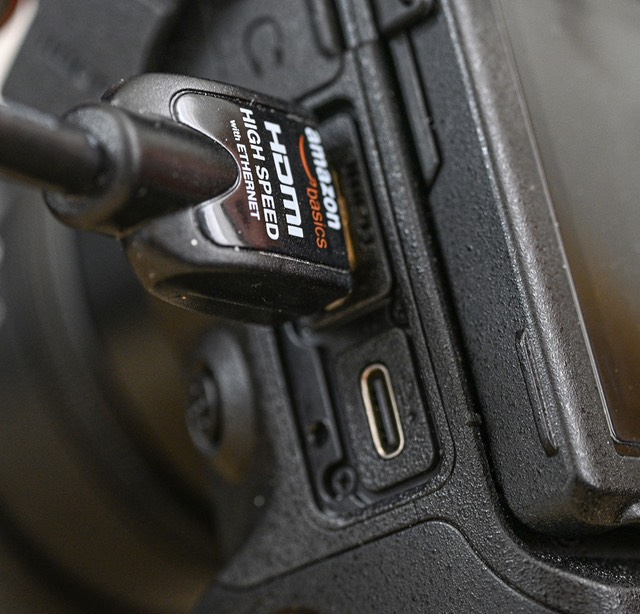
And while we're talking about connections, the Z9 has plenty, and for the most part, these are exactly what we want: USB Type C, HDMI Type A (full size), 802.3ab Ethernet (1000Base-T), 802.11b/g/n/a/ac (2/5Mhz) Wi-Fi (though with less range than the old external WT-6), Bluetooth 5.0 Low Energy, and surprisingly, GPS/GLOSNASS/GZSS location data built-in that's NMEA-compliant and able to create logs. Coupled with all that connectivity is a new NETWORK menu that includes Connect to smart device, Connect to computer, Connect to FTP, and even Connect to other cameras. Prepare to geek out if you want to get down in the bowels of that menu and configure the Z9 to connect to your favorite whatever. It can be done. It just might take some setup trial and error.
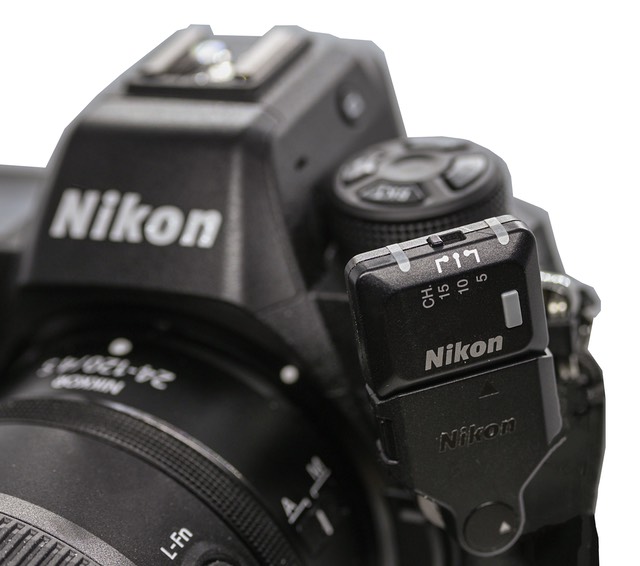
On the front of the camera we have the usual PC Sync socket and the traditional 10-pin circular connection, which supports legacy remote control options, including the WR-R10 wireless transmitter shown here (and the new WR-R11a version). Unlike previous cameras, Nikon now orients the 10-pin connector diagonally; it's a little easier to get to the lock-down rings now than it was on earlier cameras.
Nikon made a big deal about the video capabilities of the Z9 when it was announced.
Let's start with what the Z9 could do from day one: 8K 24/25/30, 4K 24/25/30/50/60/100/120, and Full HD 24/25/30/50/60/100/120. With no time limits or overheating issues (you might trigger overheating on really hot days, but I haven't yet at up to 90°F). The Z9 offers internal 10-bit recording, and three basic compressions (ProRes 4:2:2HQ, H.265, and H.264, though which are available depends upon frame size/frame rate you set). N-Log and HLG are available, as well (again, varies with frame size/frame rate as to what's available).
With firmware updates, the Z9 can now record up to 8K/50/60, and with either Nikon RAW (.NEV files) or ProRes RAW (both at 12-bit). FullHD video can be recorded (with firmware 4.0) in slow motion rates that play back in slow motion. Along with raw video, Nikon added additional video features, such as a waveform display.
As a 4K video camera, the Z9 offers a superb range of choice and it's doing so with the full sensor (oversampling). I can't imagine that anyone needing 4K is going to be disappointed with the capabilities or the results. Moreover, as many of you may have noticed from all the Z9 promotional videos making the rounds, you can record externally either with clean 4K HDMI and N-Log/HLG, or with the camera's display overlays active. A really nice touch.
Nikon has started adding "more" to their video side. Not only do we have peak level zebras available, but we also have mid-tone zebras, as well (useful for many broadcast settings, so you see that you're putting most of the signal into the best tonal range). Each of the significant firmware updates added video capabilities, so Nikon may not be done with making an already good video camera into a better one.
Storage on the Z9 is two slots that can mount XQD or CFexpress Type B cards. All the usual dual-slot capabilities Nikon has had in the past are available, including JPEG in Slot 1 — JPEG in Slot 2 (which allows you to create a full-sized JPEG and a small JPEG for pushing off the camera via SnapBridge or another connection very quickly).
I'm sure some of you will point out other things I haven't mentioned about the Z9's specifications; there's a lot going on in this new camera. If one of those things turn out to be important to note, I'll add it in an update to the review.
The Nikon Z9 is made in Thailand, and sells for US$5500 (one year warranty). Deliveries began in December 2021 and the camera was effectively on backorder until late October 2022. As this review update was done in early 2023, we now even see some Refurbished Z9 models offered. You should be able to get a Z9 from stock now.
Source of the reviewed camera: purchased via NPS Priority Purchase (disclaimer: NikonUSA leant me a preproduction Z9 a month prior to shipping my personal unit).
Nikon's Web page for the camera.
Thom's Complete Guide to the Nikon Z9 book. Over 1300 pages of detailed information and suggestions.
How's it Handle?
Those of you who've been following my work since forever are probably expecting me to write about cheese that's moved (it's a tongue in cheek reference to a seminal book). Oh boy was a lot of cheese moved by Nikon. Buttons, menus, and icons all apparently decided on mass migration with the Z9 compared to where they were on Nikon's previous flagships.
For the most part, those migrations don’t bother me much. The Z System was already establishing a bit different “button culture” than the DSLR bodies, and the Z9 simply picks up and embellishes on that, though it will stomp on some of your fingers in a number of cases. Most of Nikon’s changes make sense, a few don’t.
First up, we have the return of the Focus Mode button. However, it’s location is different. The new location is not at the lens mount, but much further back on the side of the body. This clearly impacts your hand position when using it. Whereas on the DSLRs your left thumb was in a natural position to get to the Focus Mode button, that’s no longer true. After three months of use, I’m still having trouble consistently finding it with a comfortable hand position supporting the lens. Ding the score -1.
The top button cluster to the left of the viewfinder as you’re photographing now has four buttons instead of three (+1), but the returning button positions have moved (-1) and the Metering button is now gone (completely, so -1), replaced by a Drive button I’ll get to later in this section. On the other side of the top of the Z9 the buttons have remained the same (Movie, ISO, Exposure Compensation).
Heading out back, the number one complaint I’ve heard is that the playback button became a protect button. Fortunately, it’s also programmable in playback to be…a playback button (+0). We no longer have an AE-AF lock button, which is a shame, for reasons I’ll get to (-1). The rest of the back button changes are mostly tidying up positions (+1, particularly related to the vertical grip) and conforming to the other full frame Z cameras (arguably +1). The secondary rear LCD is now gone, but the three buttons that lived below it are back, and arguably better chosen (+1), some are programmable (+1).
On the front of the camera we have three Fn buttons (+1), but their positions feel odd to a lot of people, including myself. My fingers have now grown used to their position, but…if you use the vertical grip to hold the camera, you can really only reach Fn3. This generally means that you should program Fn1 and Fn3 identically (so that you have the same function available no matter how you’re handling the camera), but that means the vertical grip hand position only can access one button while the horizontal can access two, but is likely repeating something (-1). All three buttons have more options in customization than before (+1).
With firmware updates, Nikon did something I suggested in my original review: made more buttons more customizable (+1). With firmware C3.00 or later, the Z9 is by far the most customizable camera Nikon has produced.
If you’re adding up all the dings, we keep coming back to near zero! The button scenario was literally Nikon giveth and taketh. I wish they would have giveth a bit more and taketh a bit less, but I’ve learned to live with it, particularly after Nikon fixed and added a few things through firmware updates. Indeed, I dealt with the control changes by changing what I customize and why. Here’s the downside to that: my Z9 no longer matches my Z7 II in control positions I use. I’ve written about how cognitive dissonances in controls are a bad thing. I first mentioned that almost 30 years ago, and I yelled so loud when Nikon moved the Exposure compensation button on the N80 that they put it back on the very next camera and have never moved it since. For awhile in the DSLR era we were in a good place with very few cognitive dissonances when changing bodies. With the Z9 versus the Z6/Z7 models we’re back to dealing with Apples and Oranges, and recognizing which one you have in your hand.
So you probably want some good news after that somewhat harsh section. Okay, try this: Nikon finally heard us when it came to some customizations, and even went a step further. First, we have more buttons that can be configured to almost anything, which gives us more flexibility in setting up the camera for our style. Second, most of the programmable buttons now have more options. For example, the Voice Annotation button has 24 options now (up from 3 on the D6). Moreover, buttons can be programmed differently for composing versus playback. The net effect is that the Z9 is the most customizable Z camera yet, by far, and very flexible in how you configure it. Given how sophisticated it is and how many options it has, you’re going to (eventually) appreciate that. Of course, getting started is daunting. The configuration tables I had to develop for my book are, well, extensive. Even I have to look at them for awhile before figuring out what I think I should program to what.
I noted earlier that Nikon went a step further, so I should explain. From Day One of the Z System I was loudly complaining about the removal of AF-ON+AF-area mode as a configuration option for the programmable buttons. I’ve kept that complaint up ever since, and have been joined by a chorus of other complainers. Well, it’s back on the Z9. But Nikon snuck in another option: AF-area mode. Yep, you can instantly just switch AF-area mode via button. These two things bring about a range of “hybrid” autofocusing techniques that I describe more fully in my book. I won’t go into it here because, well, there are now a ton of options, and it takes a fair amount of text to convey everything that’s possible. Indeed, one of the first updates to my book was expanding on the customization sections of the book.
The permanent vertical grip comes with some changes that are welcome, some that might not be. The welcome change is that Nikon has finally thought through the vertical grip button placement and made it better match up to horizontal grip button placement. We even get a sideways i button ;~), though it's lower and to the right of where our thumb would expect it. You can have the on-screen reminders and icons move when the camera is rotated, too, though some of Nikon's vertical position choices I might quibble with (the histogram position seems too high and centered to me, for example).
I noted in my Africa blog that my hand position felt a bit off on the Z9. I've adjusted to that over time, as usual, but I've noted quite a few people who start to use their Z9 talk about the grip. Interestingly, some like it better while some like it less than previous grips. Which just goes to show you that there's no perfect grip; hands come in all shapes and sizes, so someone is always going to complain, it seems. Still, for small hands, I suspect you'll feel like you're trying to get your hand around a dodgeball, not a softball. Personally, I feel secure in holding the Z9, even with big front-heavy lenses, though I slightly prefer the D6's grip and hand position.
The card door lock mechanism is going to come up in any Z9 handling complaint list. It might even be the number one complaint about the build quality. Basically, you have to push down on a switch while pulling back on the door. It's not comfortably or reliably done with one hand. It's near impossible when the camera is wet (mist) or you're using gloves in cold weather. Indeed, my recommendation is put the camera down on a table, pull down with your right thumb and pull back with your left thumb. I don't think that was what Nikon was intending. Some people complained about the old flagship mechanism of a small door hiding a release button. They'll stop complaining about that old method and ask for it back the minute they try getting a card out of the Z9. One thing to note: that door is removable and replaceable. I’ve encountered several Z9 owners who’ve managed to dislodge the door while trying to change cards.
The other physical part that’s going to generate complaints—I’ve already seen instances of people breaking it—is the Release Mode dial. Nikon’s thinking here probably was “all the older pro cameras have this dial, so let’s keep it.” The problem is that the choices available on the dial aren’t complete. C30, C60, and C120 (the 30 fps, 60 fps, and 120 fps options), aren’t available directly on the dial. So how do you get to them? With Nikon coming up with a “button controls dial” position (!?!?! I can’t make this up) and then adding a Release mode button and using the command dials. Which also lets you set all the other functions. So why again did we need the dial? Also, that new Release mode button comes at the expense of the metering button (it replaces it in the button cluster at top left). Worse still, you can remove functions from the new release mode button (via CSM #D3), so you now have an easy way of putting the Z9 into a “can’t get there from here state.”
I doubt that this whole release mode change was run by working photographers. If it was, I’d like to know who they are and tell them to stop consulting with Nikon. C30, C60, and C120 belong on the dial if the dial is to live on. If the release mode button is the preferred way to set modes, then drop the flimsy dial and its annoying interlock. In trying to develop a “have it your way” approach, all Nikon did was cut corners and make it more confusing than it should have been (again, there’s that Limit release mode selection option that further confuses things). All while removing a button a lot of people used. Tip: if you don’t use voice annotation, program that button to Metering. Then you have three somewhat related buttons in the bottom panel under the Rear LCD.
Finally, we have to talk about the “articulating” Rear LCD. I appreciate that Nikon decided to abandon the fixed Rear LCD of the previous flagship cameras. But the one thing I would have liked the most—the ability to flip the screen so that it faces the camera and is protected during travel—is not part of the design that Nikon came up with. Instead, we have a double-hinge mechanism with limited travel in the three directions we’d most like to move it, and too much travel in the other directions.
I saw some Nikon personnel holding the Z9 by the extended/tilted Rear LCD as if to assure everyone that it is robust enough for a flagship camera. We’ll see if they’re still doing that in a year or two (doubtful). So here we have another place where I have to assign -1 and +1 values, but they still result in a 0 “didn’t really add value” conclusion. I’m going to do something else in this review I don’t usually do, too: I recommend that you install one of those inexpensive glass protectors over the Z9’s Rear LCD. The Rear LCD is more vulnerable and not as toughened as on previous Nikon flagship cameras, in my opinion. Yanking on the tilt/tilt mechanism all the time isn’t going to help things. I’ll bet Nikon finds that they’re repairing a fair number of LCDs over time.
The problem with all these small handling glitches, particularly the physical ones, is that they make the Z9 feel a bit less robust than previous Nikon flagships. The card door, release mode dial, adjusting LCD mechanism, and even some of the controls, such as the thumb stick, all feel cheap and somewhat flimsy. Yet Nikon touts that the Z9 is “sturdier” than the D6, one of the best built cameras ever. Perhaps the frame inside is sturdier, but the exterior still could use an upgrade. Heck, Nikon didn’t even provide the D6’s big, wing-of-rubber, covers-everything hot shoe protector, but instead supplied a simpler plastic slip in protector.
Sure, maybe all these small downgrades are part of what lets the Z9 be US$1000 less expensive than a D6, but personally, I would rather pay half that back to get a more solidified camera that was thought through just a little better. That said, in over a year of abuse, including dropping the camera on a football field and dragging it through sandy Botswana, my original Z9 has held up perfectly fine.
I’ve adjusted to the Z9 and it handles well once I adjusted. I avoid the release mode dial, do as little LCD tilt as possible, put on a more substantive hot shoe cover, and I programmed a lot of customization to bring controls back to where I want them to be. And now I’m very comfortable with handling the camera. Except when I have to use the Focus Mode button or open the card slot door ;~). Ouch.
With firmware 4.0, Nikon has added some useful but complex new capabilities (e.g. Auto Capture), added some customization abilities, dealt with a small number of things that Z9 users complained about (e.g. Exposure Delay Mode is back), and tweaked a number of things, including the autofocus system.
How's it Perform?
EVF: This is not usually a category that I have to include in my reviews, but Nikon’s marketing made me do it. By that, I mean that Nikon has overpromised to reality. The promise Nikon marketing still makes is this: totally blackout free viewfinder that’s real time and has virtually no lag. That promise is incorrect. Or, I should say: has a number of limits to it.
The promise is definitely true at shutter speeds of 1/250 and faster. At fast shutter speeds it is clear that Nikon has done something magical with the Z9: the Z9 sporting and wildlife photography experience at high shutter speeds is better than Canon’s or Sony’s, both of which jitter by skipping and replaying frames, and which can have more lag to reality at times. The Z9 is smooth and provides excellent timing response at high shutter speeds.
Let’s talk about the other end next: at shutter speeds of 1/8 and slower, the Z9 viewfinder is full blackout. If you’re trying to drag the shutter while panning at 1/8, good luck, you can’t do it, because you’ll get very brief image updates between staring at 1/8 second (or longer) black segments. You simply can’t pan or keep framing with the blackout, same as with a DSLR.
It’s the in-between 1/8 and 1/250 realm that is difficult to describe, as there’s some inconsistency involved due to clock signals not lining up. The EVF data stream that Nikon talks about being in parallel with the image side is actually in parallel with the autofocus and metering stream, not the actual image stream. Thus, at the longer shutter speeds in this range you may see some blackout between EVF updates, while at the faster shutter speeds in this range, you may see jitter or repeating frames in the stream.
People keep asking me about how good do I find the Z9’s viewfinder, and they mostly center that question on the fact that it has fewer dots and a slower maximum refresh rate than some of the competitors (caveat: many of the competitors have footnotes that take away those advantages in many circumstances). Let me be clear: the Z9 viewfinder has plenty of dots, and 60Hz is just fine for most users in terms of "smoothness”. Plus it doesn’t lag.
However, using the Z9 at slower shutter speeds is definitely different and noticeable. I’d judge the Z9 EVF to be more like Sony’s A9 EVF in the lower shutter speeds that give you no blackout (only the A9 continues to jitter, skip, and repeat frames at all shutter speeds). I’d call this a “dirty” display up to about 1/250, because it doesn’t have the smoothness or total link to real time that you see once you’re using higher shutter speeds (which I'd call a "clean" display). At 1/8 and slower, the Z9 is just like a DSLR: blackout for the entire length of the image capture.
The fact that I can describe this but Nikon marketing cannot (or will not) should be embarrassing to them. Moreover, it has the consequence, once discovered by the potential customer, to make that customer doubt all the other claims Nikon makes. Thing is, Nikon has done better than Canon and Sony with the Z9 real-time EVF for most situations, in my judgement, but then is taking their claims too far. That will come back to haunt them.
Buffer: Beware, a can of worms is about to be opened. If you don’t like worms, move on.
Short version: avoid XQD cards, and if buffer size is truly important to you, get CFexpress cards with high sustained throughput.
Long version: The Z9 has a bit of a Dr. Jekyll and Mr. Hyde personality when it comes to the buffer. Let’s deal with the worst case scenario first: you only use Lossless compressed NEF. This generates the largest files the Z9 can create, and has the only substantive buffer restrictions you might encounter.
With an XQD card, 20 fps, and Lossless compressed NEF you might get 30-40 images (or less on slower cards) before the buffer fills and the camera slows down, way down. Emphasis on "might." Substitute a CFexpress card and the minimum usually jumps to around 60 images, while many will produce around 80 images before the buffer fills. On those latter cards, the frame rate will drop, maybe to between the 5-10 fps range while the buffer is full.
If you didn’t notice the number equivocation, you need to: I’ve yet to find two cards, even a different size from the same manufacturer, that produce exactly the same number of images to buffer full. This has a lot to do with how PCIe works, and how each card accesses its NAND chips. You’re going to find more speed variability with XQD and CFexpress than you’re used to with older card types, thus my ranges and nominal numbers. I’ve run through 10 different CFexpress cards now, and while they often are close to one another in the numbers they produce, there’s quite a bit of variation overall.
40 images (XQD best) and 80 images (CFexpress best) doesn’t seem like much on a 20 fps camera. That’s two seconds and four seconds before the buffer fills. So you probably want some good news. Okay, try this: set the camera to 12 fps or 15 fps. You’ll find that the Z9 will now seem to go on forever with a fast CFexpress card, as worst case tends to be in the many hundreds of images, and in one case I measured it at well over 1000 images and eventually gave up. Suddenly we’re between a half minute and full minute in buffer size! All I did was slow the camera's frame rate down a bit.
Another interesting anomaly that seems completely unexplainable: try RAW+JPEG! This actually increases the buffer for some reason. While a fast CFexpress card may hit 80 images with raw only, with RAW+JPEG enabled it'll hit near 120! I tried to work out the math of how that might be, but couldn't lock in on a variable that might suggest why you get this increase.
If that isn’t enough for you, then get out of Lossless compressed NEF (though see my comments further down). With many CFexpress cards and a High Efficiency NEF at 20 fps, you’re so far into the thousands of images in the buffer I see it as meaningless to try to get an accurate number.
Likewise, JPEG-only photographers using CFexprss aren’t going to find a problem with the buffer size (except perhaps at 120 fps on really long bursts). If you use XQD, the worst case tends to be around 90-100 frame buffer for JPEG Large fine.
I’m perfectly happy with the buffer performance of the Z9. (1) I rarely use 20 fps. (2) I mitigate things by using the right cards. (3) Even with buffer full on the right cards I’m still continuing to get continuous frames out of the camera, just at a lower frame rate.
So what are the right cards? Well, that’s difficult to say exactly, because the card manufacturers are opaque about their sustained write performance numbers. No, that’s not the number printed in big letters on the card label. For example, ProGrade has six different CFexpress Type B cards available. If you hunt, you'll find the sustained write numbers: 140MBps, 300MBps, 400MBps, 400MBps, 1400MBps, and 1400MBps. These cards have labels on them that claim 1700MBps (the read speed).
That brag number on the card label is the maximum speed for reads, or sometimes for a very short burst. It isn’t the number that will determine how big a buffer you’ll have on a Z9. The Z9 is so darned fast at pushing data out to the card, it needs high sustained rate cards, just like video cameras do. Thus, the two 1400MBps cards (Cobalt) are the preferred ProGrade cards for the Z9, not the others (Gold).
As I write this, the three card lines that have high sustained write rates I’ve been able to verify work really well in the Z9 are: Angelbird Pro AV, Delkin Black, and ProGrade Cobalt. Even then, the card size you choose may still produce differences in actual buffer size. Yes, those card lines are more expensive than the other lines, even from the same manufacturer, but you pay for performance at this level.
If you’re into video, particularly 8K or 4K slow motion or raw video, you also want fast sustained write cards.
So, here's my recommendation: buy one Angelbird Pro AV, Delkin Black, or ProGrade Cobalt card to use when you need absolutely need top buffer and video performance. All your other cards should just be whatever CFexpress Type B card you can pick up at a reasonable price, though do check the sustained right speed if you can and avoid the slowest ones. Keep your XQD cards as emergency backup or to store setup files on, but retire them from primary use if buffer is important to you.
Battery life: Ignore the CIPA rating. The CIPA battery rating was really developed for consumer cameras and casual camera use. It really is a stress test for the amount of time the battery will last. That’s because the actual test is to take an image every 30 seconds, but essentially forces the camera to be “active” the entire time. So the worst case 700 number from CIPA testing is really saying the Z9 can photograph for about five hours before exhausting the battery if you dribble out images. Nikon’s other battery statistic of 5310 images while taking bursts is sort of the opposite: it’s a least stress test.
I’ve been tracking both my and several other photographers' battery usage statistics. I’ll do a quick and dirty analysis here and say that you should easily be getting 1200-3000 images and still have some battery charge left. Exactly what the number is will depend upon a lot of things, including whether you’ve got the built-in GPS active, as well as how many bursts you’re taking versus single images.
Suffice it to say the Z9’s battery is more than sufficient for almost any use case I can see. In Africa on safari I’ve been charging my battery every night, but almost never need to. Judging from the numbers I’ve seen, a full charge probably should last me at least two days, and I take longer and more bursts than I usually do because with the Z9.
I should mention USB Power Delivery. As it turns out the MH-33 charger for the EN-EL18D battery is also a USB device. There’s been a lot of speculation on whether you’d get better charging times using something other than the lowest common denominator USB PD device that Nikon supplies, the EH-7P. The answer is mostly "not much". Putting the MH-33 on monitoring devices and using different wattage USB sources, yes, there’s a small gain from >15w sources, but in no case did I see the MH-33 drawing more than 19w (from the EH-7P I mostly see 13-14w). It’s also clear that there’s constant negotiation going on, so it’s not even a constant 19w. So you might gain some time charging with higher wattage sources, but not a lot.
Interestingly, plugging the camera directly into a USB PD source also saw a small boost over charging the battery in the MH-33 (assuming the camera was off and you were using something other than the EH-7P). But that only happens when the battery is nearly empty.
Focus: Let me state right out front that there is no perfect autofocus system. No camera on the planet is going to 100% put focus where you want it 100% of the time. Moreover, as focus systems have gotten better, I've noticed more and more people complaining about focus when it's actual something else that's triggering their issue. So all those quotes, all those YouTube videos, and all that marketing that says "it just focuses right" are dead wrong.
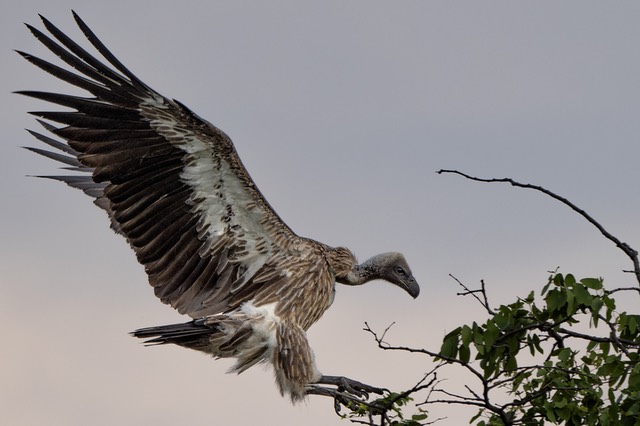
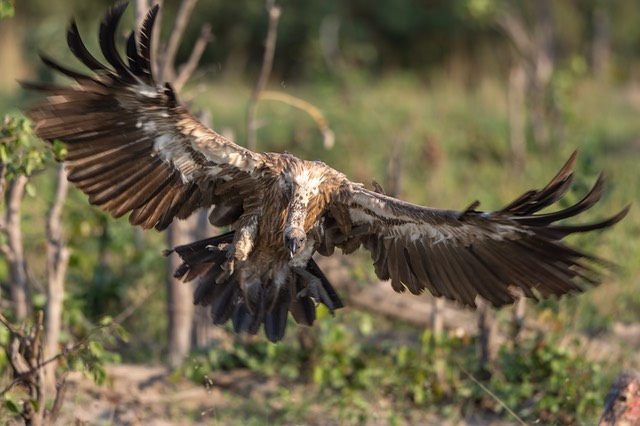
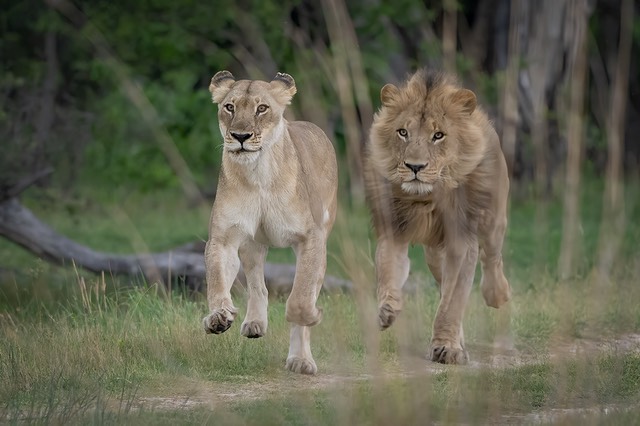
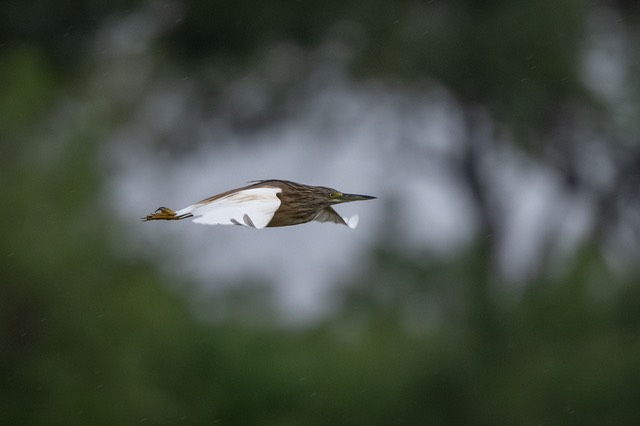
All the above samples are from long burst sequences where I let the camera do all the focusing.
Focus systems are a tool that allow you to get the results you want easier. In that regard I believe I can safely say that the Z9 will help you do that better when compared to almost any previous camera. But if you think the Z9 is now effectively just a "point and shoot" camera, you'd be wrong, and you're likely to be eventually disappointed.
Let's start with automatic subject detection and humans. I can easily say that the Z9 is the best Z System camera to date at finding and focusing on human subjects. It's darned good at it, does it at a greater distance to the subject than previous cameras, and it dials into the pupils more accurately than before. The Z9 doesn't have any real problems tracking a human. But...
The issues you might have begin to come up with multiple people in the frame. The Z9 is going to pick one person to concentrate focus on, and it will also put a faint box on the others it sees (which you can activate as the new subject by using the Direction pad). Frankly, this starts to require a lot of user input in a number of situations (e.g. event photography) in which I tried it. And my reacting and pressing the Direction pad is a "lag" that, in some cases (e.g. sports) puts me behind what's happening.
Yes, you can narrow the area over which subject detection is done. I strongly suggest you do so. You do this by choosing Wide-area AF (small) or Wide-area AF (large) or by defining and selecting one of the two custom versions Wide-area AF (C1) and Wide-area AF (C2). I’m going to go out on a limb here and say that most people using those modes don't understand them. The box you see in those modes is not a box in which the subject has to be completely contained. If you're using these modes you need to be aware that the subject detection can and will often occur outside the box. Put the box completely on someone's neck, for instance, and their eyes will be detected ;~). The larger variants of Wide-area are thus also sometimes problematic if they can see parts of two subject's simultaneously. As I suggested with the Sony A1's automatic focus detection: if you're struggling to get the camera to focus on the subject you want, narrow what the camera can see. This is absolutely true with the Z9, as well. Of course, once you go completely narrow, you now have to start moving the focus box (or camera) to keep up with the subject. That's not "point and shoot"!
3D-tracking is back on the Z9, and when it's coupled with subject detection, it can be uncanny, at least until it isn’t (this improved with firmware updates). The combination of subject, color, and pattern detection generally provides really good follow focus, even on fast or erratic motion. However, I've seen instances where for some reason it gets confused and begins to be off in its tracking. In sports, I've seen it jump to another part of a player, probably because of a light shift on the color of the uniform, or once even to another player. With animals—particularly ones that are not well recognized by the subject detection cases—I've seen it jump to another part of the animal or even the background. Beware of subjects that are the same color as the background, which is sometimes the case of birds in flight dipping below the horizon and having a natural clutter behind them instead of sky.
I know I'll get pushback on this, but I personally prefer the guarantee of closest subject priority in Group AF on my D6 to any of the Z9 choices in certain situations. There's no such "certainty mode" on the Z9, as it has the same tendency as do all Nikon and Sony mirrorless cameras to lock onto bright, contrasty backgrounds when it gets confused.
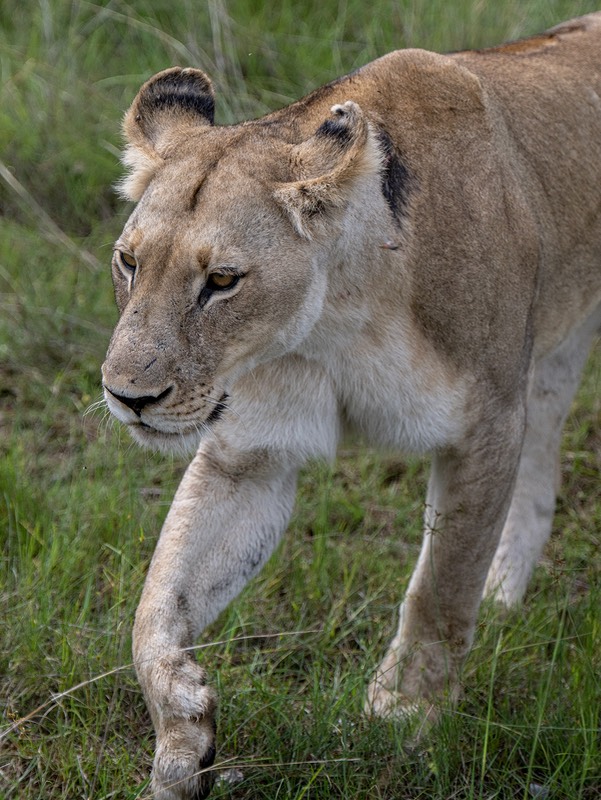
Let's push a long sequence of auto detect right up to the minimum focus of the 70-200mm f/2.8 S. Is the camera still focusing on the eye?
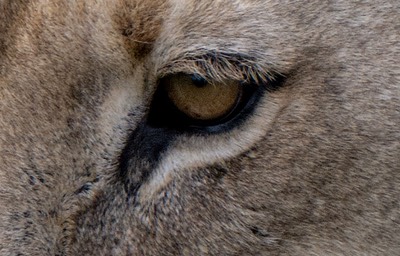
Yes. Note the iris and pupil.
Finally, there's the question that even NikonUSA seems to be somewhat confused about: low light focus performance. In a recent seminar for NPS members, Nikon said that the Z6 was the best at focusing in low light. The problem with that answer is that apples are being compared to kumquats. The increase in low light sensitivity with firmware C3.00 didn’t help the confusion.
Yes, sometimes the Z6 is the better low light camera in terms of focus. I'm talking about real low light levels, below 0EV. The reason has to do with having a bigger photosite than the Z9 (and Z7 models). More area = more photons = more data for the focus system. But it's a little trickier than that. The real advantage the Z6 has is that the focus rows have more vertical area (short axis) than the Z7/Z9. Because they have similar horizontal area (long axis) for their focus systems, what I think tends to happen in low light, particularly with low contrast areas, is that the Z6 simply finds something to grab hold of that the Z7/Z9 won't see. Maybe it finds a little short axis detail that the Z9 doesn't, and that's enough to lock on.
The kumquat stuck in the gears is that the Z6 doesn't have the focus horsepower that the Z9 has. If both cameras can see detail, the Z9 tends to win, simply because of EXPEED7 over EXPEED6. If Nikon were ever to stack the Z6 sensor and give it EXPEED7, they'd have a real winner in light where my eyes can't even focus. I'm not overly concerned about a Z9 in low light, though. I will try to make sure that it has areas of contrast to focus on, though. I could see in some pre-dawn situations with elephants, for instance, that the Z9 wasn't finding anything it could recognize to focus on, and I had to help it. Note that the subject detection mechanism doesn’t recognize an elephant, which is part of the issue.
Which brings me back to the added customizations that Nikon put back into the Z9: AF-ON+AF-area and AF-area itself. Everyone should be setting their Z9 up with some form of hybrid autofocus. By hybrid, I mean that the camera is normally set for one way of invoking focus (button and area), but you've got controls configured to immediately override that. For instance, you normally use Back Button Focus with Wide-area (Large) and Subject Detection. But at the press of another button you can do a lot of things: switch AF-area mode, or cancel Subject Detection, for instance (the latter is a kludge that involves Recall settings, but it can be done). Some wildlife photographers early on discovered that not using Back Button Focus, but to leave the shutter release set to Auto-area AF, and then program the AF-ON button to AF-ON+AF-area (3D-tracking) gave them better and more consistent results.
There are literally dozens of ways you can configure the focus system to have a split personality like that, which is why I complained so loudly to Nikon when they removed AF-ON+AF-area as a button customization on the earlier Z models. Nikon still needs to do some cleanup, but the Z9 now joins the D5/D6 (and a lesser degree D850/D500) in being able to change focus decision making on demand.
Image Quality: tl;dr: think Z7 II.
On the surface, most seem to think that Nikon took the D850/Z7/Z7 II image sensor and just stacked it. Nope. The Z9 clearly has a unique version of the image sensor, and we're still all scratching our heads about how a 52.37mp sensor becomes a 45.7mp one. I have a theory, though I can't prove it.
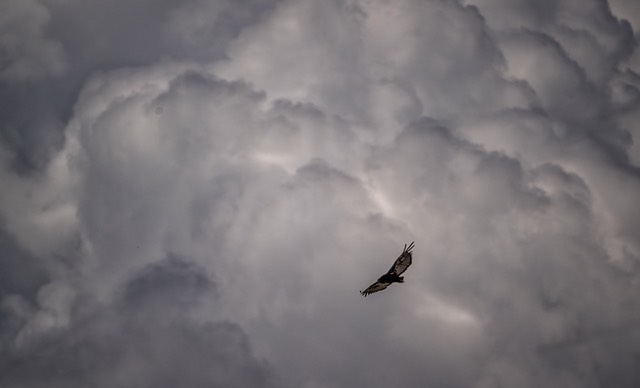
That's that the extra photosites that don't show up in the image data are used as black reference. A lot of black reference. They're masked from light and provide a great deal of information about low level pattern and noise potential. The thing that makes me say that is that the one aspect of image quality I see that's clearly changed from the Z7/Z7 II is long exposure noise. Nikon's still doing their usual things in the background, but the results are different. A 15-minute exposure on my Z9 simply doesn't show amp noise, hot pixels, or FPN the way my Z7 II does. Not that there aren't hot pixels, but they are remarkably restrained, and I couldn't find any measurable amp noise, which tends to push images magenta. And not that there isn't fixed pattern noise, but again, like the D6 it is remarkably constrained. I believe that Nikon has added extra non-light pixels on every row that gives them the ability to detect how the image sensor is changing with long exposure and heat.
Landscape photographers using strong ND filters and astrophotographers are the primary beneficiaries of the good long exposure tendencies of the Z9. For landscape, still life, and macro photography I have no reservations about the Z9's image quality. For astrophotography, it's also quite good for a standard camera with no filtration alteration.
At high ISO values, the Z9 is very Z7 II-like, though it doesn't tend towards magenta at extremely high ISO values like some previous Nikon bodies do.
I will say a couple of things I've discovered about getting best possible image quality out of a Z9. Don't underexpose if you can avoid it. It's not that you can't pull up dark detail, it's that Adobe converters aren't particularly optimized for the Z9 yet (even though Adobe now says they are). I've found, for instance, that I usually have to move the white point upwards for a Z9 NEF. However, if you do that, you'll ultimately have a bit more trouble getting the dark shadows positioned where you want them. It shouldn't be that way, but something about the way Adobe is approaching the Z9 conversions seems incorrect to me. I can make them work the way I want them to, but only by not underexposing and by using a bunch of small preset changes in the conversion.
Ultimately, the Z9 is very much like a Z7 II in image quality. I'm very comfortable running it out to ISO 1600. My typical base setting is ISO 500 if I don't use ISO 64. So, ISO 64 = 11+ stops usable dynamic range, 500 = nearly 9 stops usable range, and 1600 = almost 8 stops usable range. That's more than slide film. I have no issues with those numbers for any work, large or small, cropped or full frame. I'm also not afraid of ISO 3200 or 6400. With care in exposure and perhaps some gentle post production, they also work quite well, though I'm losing dynamic range that will force me to make some exposure decisions in highly contrasty light. Above that, I only go in a pinch, just like with my D850 or Z7 II, though again, the Z9 doesn't tend to color drift like those other two do at 12800 and above.
Which brings us to the last image quality subject to deal with: quality choices other than Lossless compressed NEF. Let's deal with JPEG first: I have to say that Nikon sure manages to make good looking JPEGs, even if you crank up the compression (but be careful of using extremes in the Picture Control parameters). In my testing, an optimal quality JPEG Fine was about 22MBs in size, while a size priority JPEG Basic was 3.9MBs, but I'd be darned if I could find much to distinguish between them at actual pixel view. Yes, the latter will tend to block up or product mosquito artifacts at times, but at 45MP I'm doubtful that you'll notice that until you make a print that isn’t getting 300 dpi.
As usual, there's nothing at all to complain about in Nikon's JPEG in-camera rendering. It's excellent, and has been since the early days of DSLRs.
The elephant in the room is High Efficiency NEF, which comes in two forms. This is really PicoRAW, a third party proprietary format created by intoPIX. EXPEED7 actually has the hardware coding in it to do this form of compression, and is wicked fast in doing so. To the point where that 80 frame buffer on some cards suddenly becomes a 1000+ frame one.
I continue to evaluate High Efficiency* but my conclusion so far is that you get a bit of extra noise in the deep shadows but no other observable changes. That means that if you have a raw converter program that can handle the format, there’s virtually no penalty to do so and a huge benefit from a vastly increased buffer size. The benefits of High Efficiency are real: smaller file size, huge buffer, with little or no visual impact on final image.
Note that we've seen HE before. As in HEIC or HEIF files. (HEIC is High Efficiency Image Container, HEIF is High Efficiency Image File Format [where's the second F?]). These are actually a derivative of HEVC (H.265) compression that's tailored for still imagery. What's unclear is what compression is actually used in the Nikon versions. Is it JPEG 2000, JPEG XR, JPEG XS, or something else?
Because High Efficiency is really a compression controlled by a third party (intoPIX), that means that raw converters are dependent upon the PicoRAW SDK from intoPIX, which took some time to provide Apple Silicon routines. As I refresh this review, Nikon NX Studio, Adobe ACR/Lightroom, Capture One 22, DxO PhotoLab 6.7, and On1 RAW, all directly support the High Efficiency file NEF files. Because Apple provides support for the format in macOS Ventura and the current iPadOS, some third party developers using the Apple-provided routines may also be able to do so (e.g. Affinity Photo 2 can use the Apple routines).
I use the High Efficiency formats when I need the buffer space, otherwise I stick to Lossless compressed NEF.
Final Words
There's been a lot for me to write because the Z9 is a lot of camera. Despite my preface at the start of the review, I think I need to repeat this: the Z9 is the best Z System camera, by far, and arguably one of the two or three best cameras you can buy, period. Which is saying a lot, and should be viewed as a highly positive comment. Given the US$5500 price—which places it lower than the Canon R3 and Sony A1—it's difficult to complain about what you're getting for your money. The Z9 is a top performer, and a bit of a bargain.
- Compared to the Canon R3 — The Z9 has more pixels, no mechanical shutter, 8K video (with no overheating), and costs less.
- Compared to the Sony A1 — The Z9 has no mechanical shutter, no video limits (or overheating issues), and costs less.
- But...My advice is the same as always: don't be a mount switcher. There's much to be said in keeping continuity of lenses, accessories, menus, nomenclature, and other UX. Once in a system, you should stick with that system, I believe.
The Z9 still has some rough edges. Much of the time I’ve been using and reviewing the Z9 it's sat next to my D6, both in my bag and on my desk. The Frame Advance dial, card door, the hot shoe cover, and a few other bits and pieces all feel like they're below the well-established Nikon flagship build level, for instance. Odd choices can be found for some of the controls and the way the menus were reorganized. We received built-in GPS and a better Wi-Fi transmitter, but the wireless radio transmitter for remotes and flash still uses a 10-pin connector and is optional. Frequency tuning is missing on Photo flicker reduction. The video features weren't complete at launch and require a major firmware update, yet to appear. We still don't have any focus mode that truly guarantees closest subject priority, and we lost the ability to configure focus patterns that we gained on the D6. Plus we didn't even get Portrait impression balance, a feature added to the Z6 II, Z7 II, and Z8.
And yet, despite it's extra size and weight, the Z9 is now the alpha camera in my camera bag—see what I did there? ;~)—and I’ve added a second and said good-bye to one of my other Z camera bodies.
Anyone who took a university course from me knows that the better you got, the tougher I got on you, and I feel something akin to that happening with this review. Nikon produced a great camera, but missed just enough small things that would have taken it to perfection that it's frustrating to me. I feel like the umpire trying to figure out if hitting the ball off the top of the wall in deep center field and it landing in the stands is a home run or a ground rule double. (For those who don't know, in most parks, such as the Coors Field in Denver I'm familiar with, that's considered a home run, but doesn't that still feel a little bit wrong? And let's not get started on baseball parks with a yellow line on the wall.)
Finally, we have price to talk about. Nikon's previous flagships have tended to range from US$6500 (most) to US$8000 (D3X). The Z9's US$5500 price seems almost like a bargain in perspective, but I think that price simply reflects Nikon's intent to see how many DSLR users they can quickly pull over into mirrorless at the top level. That’s been working. Every Nikon-using working professional I know opted for one.
My recommendation, below, may surprise some of you after all my negativity about things. As I’ve written several times, the Z9 is about the best camera you can buy, if not the best.
Highly Recommended (2022 to present after firmware updates)
Support this site by purchasing from the following advertiser:
I’ve removed my 43-item bug list from the review, as quite a few of them were removed, others had changes that made them understandable, and the couple that were left aren’t bothersome enough to worry about.
On the other hand, since Nikon has been adding features to the Z9 for over a year, I’m leaving a shortened version of my firmware update requests, below):
- Named Save/Load menu settings files. The Sony A1 has this, the Z9 absolutely needs it to stay competitive. Yes, banks are good, but the Z9 is an "all-around" camera. I want a settings file for safari, another for sports, another for events. Within those settings files I want to use the banks to better configure the camera for the type of photography I'm doing, not leaving them set for a type of photography I'm not doing at the moment (e.g. a bank for Sports, a bank for safari, etc.). Realistically, the whole Customizations/Banks/Settings construct needs a lot more thought and refinement. For example, why can't I save a bank to a named file? That would give me more banks to work with. Update: firmware 4.00 adds the ability of NX MobileAir to save and name settings sets on your mobile device, and then restore those back to your Z9. This, as well as FoCal Snapshots, another mobile app, gives us what I asked for, though in indirect ways. It would still be beneficial to have those named files on the camera itself.
- We still have the silly setting file naming convention that comes from the 1980's, where one number is what designates which camera the file is for. Gee guys, how is it that I'm supposed to remember NCSET010.BIN stands for Z9 (10 stands for 9?) and NCSET008.BIN stands for Z7 II (8 stands for 7?). This nonsense has to stop. If you don't see the solution, let me give you the example: Z9SET###.BIN gives us plenty of settings files. Heck even Z72SET##.BIN gives us plenty. So if we don't get #3, give us this, please.
- Speaking of banks, we still don't have the ability to combine Shooting menu and Custom Setting banks. There are times when I want Shooting menu bank A and Custom Setting bank C, and others when I want Shooting menu bank B and Custom Setting bank B. I can't immediately reconfigure the camera with one command for either case. Named settings files would partially solve this, but on-the-fly-via-button changes aren't possible across the entire customization set the way things stand.
- Add Video Recording banks instead of tying them to the Shooting menu banks. Of course, adding Video Recording banks compounds the issue of combinatorial bank setting I note in #5.
- The new On/Off quick set from the menus is nice, but I think Nikon could go further. For example, High ISO NR has only four obvious options. Why do I need to drop to another page to change the value? Why not right press to get to the next value (ala the On/Off options)? Color space only has two choices, why another menu page for that instead of a toggle? The On/Off menu option was a good choice, but not thought through entirely. Other candidates for quick setting like this are: Slot empty release lock (lock, release), USB connection priority (upload, shooting), Sensor shield behavior (closes, open), Finder display size (photo Lv) (small, standard), Delete pictures from both slots (confirm, yes, no), Dual-format recording PB slot (Slot1, Slot2), Picture review (On, Monitor, Off), After delete (next, previous, continue), and After burst, show (first, last)
- Where's Portrait impression balance and Skin softening? The II's have the former, the Z8 has both, why didn't the Z9 get either in firmware updates? This is poor behavior on Nikon's part. A photographer with a Z7 II, Z8, and Z9 simply can't make images match without these function (assuming they use it, which people/event photographers should, otherwise it doesn't need to be there at all).
- Bring back the 5:4 Image area. Also, let the camera record full frame for DX lenses. As I've pointed out many times, even a number of Nikon DX lenses cover the full frame.
- Why can't we have Zebra patterns in still photography?
- Is Nikon ever going to do Pixel Shift? Apparently not. The Z9 was the camera (all-around camera) that would have most benefited from it.
A longer Nikon Firmware Wish List is elsewhere on this site.
